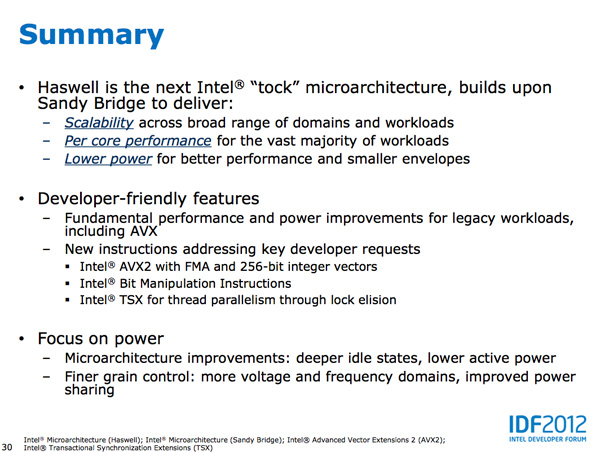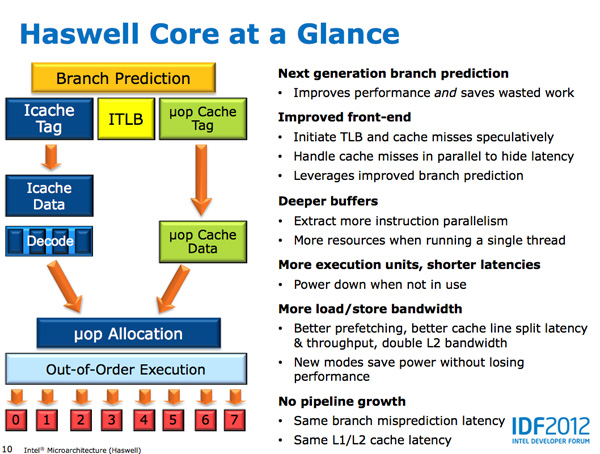Intel's Haswell Architecture Analyzed: Building a New PC and a New Intel
by Anand Lal Shimpi on October 5, 2012 2:45 AM ESTFinal Words
After the show many seemed to feel like Intel short changed us at this year's IDF when it came to architecture details and disclosures. The problem is perspective. Shortly after I returned home from the show I heard an interesting comparison: Intel detailed quite a bit about an architecture that wouldn't be shipping for another 9 months, while Apple wouldn't say a thing about an SoC that was shipping in a week. That's probably an extreme comparison given that Apple has no motivation to share details about A6 (yet), but even if you compare Intel's openness at IDF to the rest of the chip makers we cover - there's a striking contrast. We'll always want more from Intel at IDF, but I do hope that we won't see a retreat as the rest of the industry seems to be ok with non-disclosure as standard practice.
There are three conclusions that have to be made when it comes to Haswell: its CPU architecture, its platform architecture and what it means for Intel's future. Two of the three look good from my perspective. The third one is not so clear.
Intel's execution has been relentless since 2006. That's over half a decade of iterating architectures, as promised, roughly once a year. Little, big, little, big, process, architecture, process, architecture, over and over again. It's a combination of great execution on the architecture side combined with great enabling by Intel's manufacturing group. Haswell will continue to carry the torch in this regard.
The Haswell micro-architecture focuses primarily on widening the execution engine that has been with us, moderately changed, for the past several years. Increasing data structures and buffers inside the processor helps to feed the beast, as does a tremendous increase in cache bandwidth. Support for new instructions in AVX2 via Intel's TSX should also pave the way for some big performance gains going forward. Power consumption is also a serious target for Haswell given that it must improve performance without dramatically increasing TDP. There will be slight TDP increases across the board for traditional form factors, while ultra portables will obviously shift to lower TDPs. Idle power drops while active power should obviously be higher than Ivy Bridge.
You can expect CPU performance to increase by around 5 - 15% at the same clock speed as Ivy Bridge. Graphics performance will see a far larger boost (at least in the high-end GT3 configuration) of up to 2x vs. Intel's HD 4000 in a standard voltage/TDP system. GPU performance in Ultrabooks will increase by up to 30% over HD 4000.
As a desktop or notebook microprocessor, Haswell looks very good. The architecture remains focused and delivers a sensible set of improvements over its predecessor.
As a platform, Haswell looks awesome. While the standard Haswell parts won't drive platform power down considerably, the new Haswell U/ULT parts will. Intel is promising a greater than 20x reduction in platform idle power and it's planning on delivering it by focusing its power reduction efforts beyond Intel manufactured components. Haswell Ultrabooks and tablets will have Intel's influence in many (most?) of the components placed on the motherboard. And honestly, this is something Intel (or one of its OEMs) should have done long ago. Driving down platform power is a problem that extends beyond the CPU or chipset, and it's one that requires a holistic solution. With Haswell, Intel appears committed to delivering that solution. It's not for purely altruistic reasons, but for the survival of the PC. I remember talking to Vivek about an iPad as a notebook replacement piece he was doing a while back. The biggest advantage the iPad offered over a notebook in his eyes? Battery life. Even for light workloads today's most power efficient ultraportable notebooks can't touch a good ARM based tablet. Haswell U/ULT's significant reduction in platform power is intended to fix that. I don't know that we'll get to 10+ hours of battery life on a single charge, but we should be much better off than we are today.
Connected standby is coming to PCs and it's a truly necessary addition. Haswell's support of active idle states (S0ix) is a game changer for the way portable PCs work. The bigger concern is whether or not the OEMs and ISVs will do their best to really take advantage of what Haswell offers. I know one will, but will the rest? Intel's increasingly hands on approach to OEM relations seems to be its way of ensuring we'll see Haswell live up to its potential.
Haswell, on paper, appears to do everything Intel needs to evolve the mobile PC platform. What's unclear is how far down the TDP stack Intel will be able to take the architecture. Intel seems to believe that TDPs below 8W are attainable, but it's too early to tell just how low Haswell can go. It's more than likely that Intel knows and just doesn't want to share at this point. I don't believe we'll see fanless Haswell designs, but Broadwell is another story entirely.
There's no diagram for where we go from here. Intel originally claimed that Atom would service an expanded range of TDPs all the way up to 10W. With Core architectures dipping below 10W, I do wonder if that slide was a bit of misdirection. I wonder if, instead, the real goal is to drive Core well into Atom territory. If Intel wants to solve its ARM problem, that would appear to be a very good solution.












245 Comments
View All Comments
dishayu - Friday, October 5, 2012 - link
Woah! I did not even think of that. That is VERY compelling but i can't do without unlocked multiplier, so there is no perfect processor for me still :(StevoLincolnite - Friday, October 5, 2012 - link
Or just go with a Socket 2011 Core i7 3930K like I have and do a little bit of undervolting and has no IGP's.I think the reason why the Desktop space has seen decreasing/stagnant sales is simply because allot of people see no need to upgrade.
A Core 2 Quad Q6600 @ 3.6ghz, with a decent chunk of Ram and a decent graphics card is actually fairly capable of running almost every game at maximum settings.
Heck I know people who are perfectly happy sitting with a Pentium 4 for basic web use.
I think a change needs to happen where software catches up with hardware to give people a reason to upgrade and drive sales which might reinvigorate Intel and AMD to innovate.
Windows 8 and the next generation consoles might actually help in that regard.
De_Com - Friday, October 5, 2012 - link
Well said Steve. Couldn't agree with you more.
I'm running a Core 2 Extreme QX6850 at 3.4ghz, 1066Mhz DDR2 Ram and a GTX295 and it still rocks all the newest games at or close to max settings.
Will have this system 4 years this November.(all except the GTX295, which was upgraded from a 9800 GX2), even now I'm thinking that was a waste of cash.
I've gone to upgrade at least twice each year, but can't justify it.
The only place I'd see returns is in the power costs, but hey, whats a few extra cents.....
The system meets my needs, and forking out for a similar system today would cost around the €1800 mark.
Until the software can better utilize the components I'm holding out until Summer 2013, that'll be over 4 years I've gotten out of this system. Up until 2008 I slavishly upgraded every year or 2.
lukarak - Saturday, October 6, 2012 - link
This (late) December, i will have had my i7 for 4 years, and i have not seen a single reason to upgrade. The GPU is 2.5 years old (GTX480, was 280 before that).A x58 motherboard has 6 memory slots, and now houses 24 GB of ram for virtual machines, which can go 48 GB for a reasonable price.
I just don't see the need to do anything more, and this will probably fail from old age before i would need a drastically faster machine.
xaml - Thursday, May 23, 2013 - link
"but hey, whats a few extra cents....."Sure, it's probably not your generation to take the hit, having to deal with the consequences of energy excesses.
DanNeely - Friday, October 5, 2012 - link
Is that actually an IGPless chip, or just a standard LGA1155 quadcore chip with a disabled IGP.csroc - Friday, October 5, 2012 - link
I don't mind power savings, the few times my system is idle it could certainly benefit but overall it would mean reduced consumption even under load. My system just doesn't spend enough time in idle with my Q9450.Ultimately it does seem as though the software demand for faster CPU hardware has slowed and between that and the lack of real competition, so has the development.
If it weren't for the fact that I need more RAM or wanted faster photo processing (and may start doing some video) I'd probably keep what I've got a bit longer. My Q9450 hasn't held me back from playing any games yet. The 20% OC I've been running doesn't hurt but ultimately a lot of things just aren't CPU limited anymore.
Kidster3001 - Monday, October 15, 2012 - link
If you're playing 3D games then your CPU is likely "idle" 50%-75% of the time. Idle time does not just mean when the display is off.IanCutress - Friday, October 5, 2012 - link
You may think this as a result of all the low power talk, but Haswell is doing something rather important on the peak performance side. The increase in the size of the execution engine is important - adding in another integer ALU and another load/store means that in workloads that share INT and FPU performance (think loop counters which store an INT for loop iteration then perform some FP calcs) will improve. By increasing the bandwidth available and being able to keep the two FPU fed with info means a greater throughput as long as the bandwidth and thread switching can hide any additional L3 latency. Personally I'm thinking this may be a subtle move towards more threads per core in future architectures. Some of the non x86 are abusing 8 threads/core with improvement gains, so I wonder if that would be possible here. Ideally we would like every port on the execution engine to do everything, with a single pipeline feeding it and excellent branch prediction to help with single thread speed. Smaller nodes help with that silicon real estate, or someone will stumble on a better/smaller way to actually physically create these things.Ian
DanNeely - Friday, October 5, 2012 - link
I'm curious what IBM/Oracle's high SMT designs look like on the execution port side. As long as it's business as usual I doubt Intel will ever make all the ports do everything because it would just be hogging a huge amount of die area when the odds of each thread doing all of the same instruction type constantly are very low. Smaller bursts of one type can be spread out using OOOE.